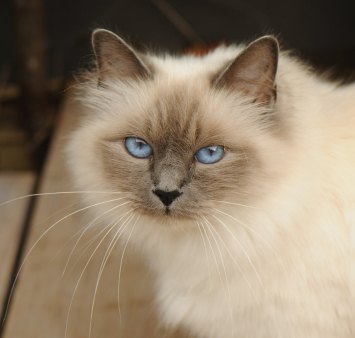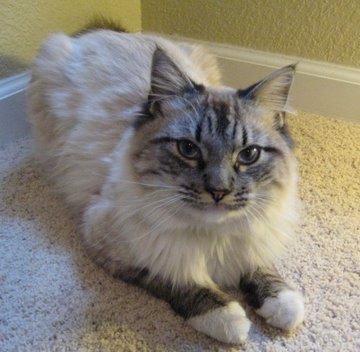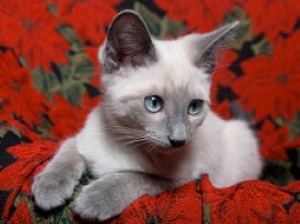- Home
- Related Breeds
- Birman
The Birman Cat Breed: Where Do Birman Cats Come From? The Birman’s Legendary Past
Of all the cat breeds, Birman cats have the most mysterious origins. The Birman cat breed's history is all rather puzzling!
Not much is actually known about it, although there's a legend or two surrounding their early beginnings.
The Birman breed is also known as the 'Sacred Cat of Burma'. Birmans (like the legendary Siamese cats in Thailand) were said to be Burmese temple cats.
Legend has it that the Birman was a pure white, long-haired cat with yellow eyes. One particular legend concerns a temple cat called Sinh. Sinh belonged to a priest who was killed by intruders when his temple was raided.
The priest was said to have been at prayer in front of a statue of a golden goddess with sapphire eyes at the time of his death. After his master was killed, the cat jumped onto the priest's body.
In accordance with the Buddhist belief that cats continued to house their masters' souls after death, the priest's soul passed into the cat.
The cat's eyes turned sapphire-blue and his fur became shaded with gold, reflecting the nearby statue of the goddess.
 Blue point Birman (with 'golden' aura)
Blue point Birman (with 'golden' aura)Image © iStockphoto | David Cannings-Bushell
The cat's feet, where they had been touching his master, remained pure white (reflecting his master's holiness) but his paws, tail, ears and face turned dark brown – the color of the earth on the temple floor.
This coloring (shown in the pictures of the Birman breed on this page) was then passed on to all the other temple cats.
Birman Cat Breed History
Historically, the first Birman-like cat appeared in France in the 1920s.
Some say that a pregnant queen was smuggled out of Burma to France, others that a pair of Birmans was sent to France to thank a French explorer for providing assistance to Burmese temple priests.
Still others say that the Birman breed was developed in France, crossing short-haired Siamese with long-haired black and white cats, but there's no evidence for this.
Whatever their origins, it is clear that the breed standard was first written in France, and that the Birman cat breed was first recognized in that country in 1925. (The Birman breed name is in fact derived from their French name Sacré de Birmanie.)
After the Second World War, cats from France were taken to Britain and America where the breed was registered in the 1960s.
Despite their Burmese origins and name, the Birman cat is not related to the Burmese, which is short-haired and a completely different type.
 Seal point Birman, showing the white feet
Seal point Birman, showing the white feetImage © iStockphoto | Isabelle Mo
Birman Characteristics
Birman cats have bright blue eyes and four pure white feet.
Their eyes are round, set in a broad, rounded head – in fact these cats are broad all over, not long and thin like a Siamese. They're large, with solid legs and stocky bodies.
The front white feet markings, called 'gloves', should be short and symmetrical, ending in an even line. On the hind feet these markings are called gauntlets (or laces, in the USA) and should extend up the back of the paws to a point below the hocks.
Birmans have long, silky coats with no undercoat, big ruffs around their necks and thick, bushy tails. Their coats tend not to mat or tangle, making them easy to care for although like all long-haired cats they do need daily brushing and combing to keep their coats in good condition.
Apart from their white feet, they have the Himalayan or Siamese point pattern with mask, ears, tail and paws in the seal, blue, chocolate, lilac, red and cream point colors as well as the tabby (lynx) and tortie varieties of these colors.
Birman Kittens
A Birman kitten is born pure white, with pale blue eyes. The point colors first appear on the ears and tail, and darken slowly as the kitten grows; their eye color also deepens as they get older.
Birman Cat Breed Behavior, Personality and Temperament
The Birman is a gentle, friendly, happy breed; they're extremely good-natured which makes them ideal family cats. They are playful (but not as lively as a Siamese!) and always interested in what's going on around them.
They do like to have plenty of space so would probably be better off in a house than an apartment.
 Blue lynx point Birman
Blue lynx point BirmanImage Wikimedia Commons | Kmmatney
Further Reading
For more information about Birmans and their history, health, temperament and care, Birman Cats - The Owner's Guide from Kitten to Old Age by Rosemary Kendall, available on Amazon, is excellent and full of helpful advice and information for all Birman cat owners.
More Siamese Relatives
Some of the articles and newsletters on this site may contain links to products I think you may enjoy. If
you purchase through these links I receive a small commission, but there's
no extra cost to you. Find out more on the Affiliates Disclosure page.
Have You Discovered Our Newsletter?
If not, why not? Subscribe to our email newsletter, Meezer Musings, to stay in touch, be the first to see new information and pages as they come out, and read the things we only talk about in the newsletter.
Learn more about it on our Newsletter Sign-Up page.




